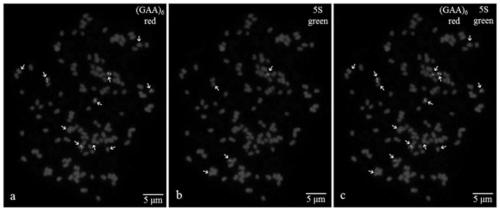Fluorescence in situ hybridization method for metaphase chromosomes of Zanthoxylum bungeanum
A technique of fluorescence in situ hybridization and Zanthoxylum bungeanum, which is applied in the fields of cytogenetics and molecular biology, can solve the problems of difficult seed germination, difficult clipping of root tips, long time, etc., and achieves less probe DNA and less probe Ease of preparation and improved detection efficiency
- Summary
- Abstract
- Description
- Claims
- Application Information
AI Technical Summary
Problems solved by technology
Method used
Image
Examples
Embodiment Construction
[0020] The probe sets used in the implementation of the present invention are all synthesized by Beijing Sangong Company. The synthesized probes are diluted with 1×TE to a concentration of 100M and stored at -20°C. Store at ℃.
[0021] The present invention will be described in further detail below in conjunction with the accompanying drawings and specific embodiments, which are explanations rather than limitations of the present invention.
[0022] A specific embodiment of the present invention provides a method for fluorescent in situ hybridization of metaphase chromosomes of Zanthoxylum bungeanum, comprising the following steps:
[0023] 1) Preparation of mid-stage chromosome slide specimens of Zanthoxylum bungeanum: Transplant the annual Zanthoxylum bambooi plant grown in the field into a pot filled with nutrient soil, and cultivate it at room temperature for two months until the root tip grows to 1.5 ~2.0cm, cut 1~1.5cm root tip tissue at 10:30 am and 4:30 pm, and use N ...
PUM
 Login to View More
Login to View More Abstract
Description
Claims
Application Information
 Login to View More
Login to View More - R&D
- Intellectual Property
- Life Sciences
- Materials
- Tech Scout
- Unparalleled Data Quality
- Higher Quality Content
- 60% Fewer Hallucinations
Browse by: Latest US Patents, China's latest patents, Technical Efficacy Thesaurus, Application Domain, Technology Topic, Popular Technical Reports.
© 2025 PatSnap. All rights reserved.Legal|Privacy policy|Modern Slavery Act Transparency Statement|Sitemap|About US| Contact US: help@patsnap.com

